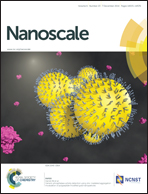Nanowire-based multifunctional antireflection coatings for solar cells†
Abstract
Organic (P3HT/PCBM) solar cells are coated with ZnO nanowires as antireflection coatings and show up to 36% enhancement in efficiency. The improvement is ascribed to an effective refractive index which results in Fabry–Perot absorption bands which match the polymer band-gap. The effect is particularly pronounced at high light incidence angles. Simultaneously, the coating is used as a UV-barrier, demonstrating a 50% reduction in the rate of degradation of the polymers under accelerated lifetime testing. The coating also allows the surface of the solar cell to self-clean via two distinct routes. On one hand, photocatalytic degradation of organic material on ZnO is enhanced by the high surface area of the nanowires and quantified by dye degradation measurements. On the other, the surface of the nanowires can be functionalized to tune the water contact angle from superhydrophilic (16°) to superhydrophobic (152°), resulting in self-cleaning via the Lotus effect. The multifunctional ZnO nanowires are grown by a low cost, low temperature hydrothermal method, compatible with process limitations of organic solar cells.


 Please wait while we load your content...
Please wait while we load your content...